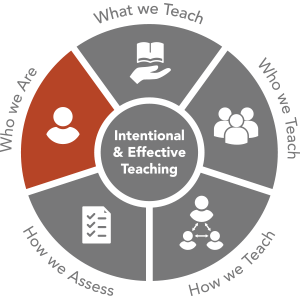Who am I?
Who am I?
When trying to create a respectful and inclusive classroom, it may seem obvious that instructors should strive to understand their students. It may be less obvious how useful it is to know ourselves.
Know your course goals
Our goals in a specific course are related to content, which may be related to departmental, university, disciplinary expectations and personal choices. This content may or may not have direct connections to human diversity or multiculturalism. Being very clear about what we hope to achieve helps us to decide what is within and beyond the scope of the class. It also increases our chances of success.
Regardless of the content, we also have goals and values related to classroom environment, pedagogy, assessment, and feedback. Ideally at least some of these pedagogical areas are designed with issues of fairness and inclusiveness in mind.
Know yourself as a teacher
Faculty members have varied teaching personas, and there are many different roles we may inhabit in the classroom: Do you see yourself as primarily as a facilitator? Authority? Role model? Mediator? Presenter? Provocateur? Devil’s advocate? Coach? Co-learner? Manager?
Knowing yourself as teacher also means reflecting on: Which pedagogical strategies are you comfortable with (or not)? Which ones would you like to (or do you need to) become comfortable with?
As experts in our field, we tend to forget what it was to be a novice like our students. Students may struggle or take longer to grasp material than we expect. How can we learn where they do and figure out the best ways to help them get the to point we want?
Know what you know (and what you don’t)
It helps if we reflect upon what we know about various types of peoples and cultures. Some of us know more about people from certain parts of the world, different religious traditions, cultures, various types of disabilities, etc. We all are more familiar with what we already have been exposed to or studied. As with any other kind of knowledge, we can pinpoint where we need to learn more in order to grow as faculty.
Recognize that even if we have strong egalitarian values, we may unknowingly behave in discriminatory ways or have unconscious biases influence our interactions. We can become familiar with the science on implicit bias as well as strategies to address unconscious biases.
Do you want to grow in your intercultural competence? Elon’s Office of Inclusive Excellence Education & Development offers opportunities to foster individual and collective reflection on the complexities of identities and skill building around reducing and intervening biased behaviors. These include dialogues, workshops, reading groups, and an intercultural consciousness certificate. The Center for Race, Ethnicity, and Diversity Education (CREDE) and the LGBTQIA Center, among other centers on campus, also offer resources, discussions, consultations, ally training, and workshops for faculty. Consult the Division of Inclusive Excellence calendar for related programming and development opportunities.
Know yourself
We are all unique, with multiple parts to our identities. Whether we realize it or not, our education, experiences, identities, preferences, values, stereotypes, and blind spots may affect us in the classroom. In “Four Strategies to Engage the Multicultural Classroom,” Christine Stanley and Matt Ouellett suggest questions to reflect upon before team teaching. But some of those same questions may help us in whatever circumstances we teach in – so that we might consider what our students feel like and how we want to behave:
- How do your friends describe your personality? How much of your personality do you bring into the classroom?
- When was a time you have felt different from others? felt powerful? felt ignored? felt you were not treated fairly? How do these memories impact how you teach?
- How comfortable are you asking for help?
- Do you share parts of your identity with students? Which ones and why or why not?
- What strengths do you bring to the table in teaching?
- What theories or experiences impact your strategies about teaching the many types of students you encounter?
- Do you remember tense experiences in a classroom? What sorts of things do you think should be responded to immediately in class versus later?
- When students say they’re interested in having a “safe environment,” what does this mean to you?
- When the class is silent, how do you interpret that silence?
- What student behaviors do you find frustrating?
- How do you feel when students disagree with your strongly held values? How do you want to react?
Works Cited & Resources
Questions above adapted from a “Self-Assessment Questionnaire,” supplemental materials from “Four Strategies to Engage the Multicultural Classroom,” a webinar available to Elon faculty (password required) facilitated by Matt Ouellette and Christine Stanley.
Lerita Coleman, “The Influence of Attitudes, Feelings and Behaviors Toward Diversity on Teaching and Learning.”
University of California-San Francisco Office of Diversity and Outreach, “Unconscious Bias.”
Women in Science & Engineering Leadership Institute (WISELI), “Benefits and Challenges of Diversity in Academic Settings.”